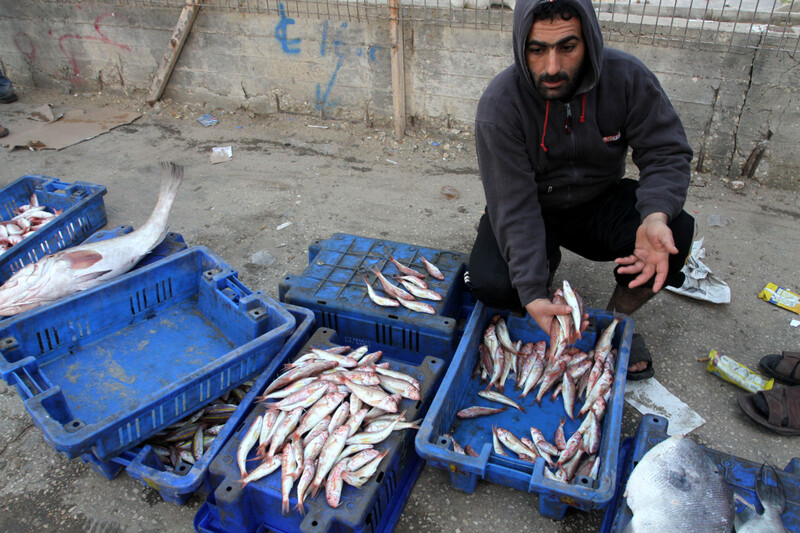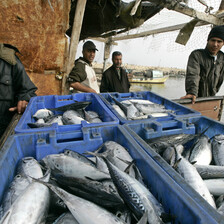The Electronic Intifada Gaza Strip 14 December 2012

The Israeli navy continues to shoot at Palestinian fishing boats well within the range agreed upon for the ceasefire deal.
APA imagesGAZA (IRIN) - When Jaber Abu Rjaila heard about the recent ceasefire agreement in Gaza, he rushed back to his farmland — for the first time in more than ten years.
“We have been farmers for generations. It’s our life and I’m very glad that we are back here now freely working,” he said. “I’ve been longing for this moment.”
His farmland lies in the “access-denied” and buffer zone areas close to the Israeli-built barrier, but the recent ceasefire agreement holds out the promise of an easing of naval and land controls at the border.
Oxfam says the five-year blockade by Israel has “devastated Gaza’s farming and fishing industries,” leading to the closure of nearly 60 percent of Gaza’s businesses, according to a new briefing paper published this month (“Beyond Ceasefire,” 6 December 2012).
Abu Rjaila has ambitions to plant tomatoes, parsley and zucchini for sale, and to help feed his 14-member family. But he knows he is not in the clear yet.
Israeli soldiers often use their loudspeakers to tell him to keep tens of meters from the barrier — and he still worries about random shooting, sudden Israeli incursions, and unexploded shells.
Abu Rjaila’s house and land are about 450 meters from the border in eastern Khan Younis, where he owns a seven-hectare farm on some of the most fertile land in Gaza (one hectare is equal to 10,000 square meters).
After the ceasefire was introduced on 21 November, bringing to an end Israel’s eight-day attack on Gaza, hundreds of Palestinians who own houses and land in these areas returned.
Israeli gunfire
Officials in Gaza say the Israelis agreed to ease travel and economic restrictions, although the returning farmers faced immediate warnings from Israeli forces saying “go away” and “go back,” often accompanied by warning shots.
Palestinian medical sources said one Palestinian was killed and more than 20 injured by Israeli gunfire in the area just two days after the ceasefire, when a group including farmers visited land close to the fence.
Ibrahim al-Qedra, the deputy agriculture minister in Gaza, said that the easing of restrictions on the 5,000 hectares in the buffer zone would reduce humanitarian needs in Gaza.
“We need to reach our border areas and lift the buffer zone restrictions to let people return to their lands, live in their houses, and farm their lands freely — we need to restore our food security.”
Historically the area was a major food source for Gaza with citrus and olive orchards, and seasonal production of tomatoes, cucumbers, onions and potatoes for local markets.
The UN Office for the Coordination of Humanitarian Affairs (OCHA) confirmed the development shortly after the ceasefire was announced: “For the past few days, farmers have been allowed to access, with their equipment and vehicles, agricultural land located as close as 100 meters from Gaza’s perimeter fence in some areas,” OCHA stated (“Escalation in hostilities, Gaza and southern Israel,” 26 November 2012 [PDF]).
The ceasefire agreement regarding the easing of restrictions near the border remains vague, though.
“We don’t have a clear signal from Egypt about the full access; people returned to their lands voluntarily while we are still discussing the mechanisms in the current indirect negotiations to reach an understanding regarding these areas,” said al-Qedra.
“We ask the public to be careful when heading there,” he said.
Threats to fishermen
The situation is similar for Gaza’s fishermen.
Since 2006 the Israeli navy has only allowed fishermen like Mohammed Abu Riala, 32, to operate up to three miles from shore. With the ceasefire they were told they could head out six nautical miles.
“It’s good news in principle. As soon as we heard about the expansion to six miles range we sailed to that spot. But we faced the same Israeli soldiers’ threats through loudspeakers: ‘return, go back or …,’ and several warning shots in the water, over our heads, and close to our boat.”
A number of his fellow fishermen have already been arrested and taken to the Israeli port of Ashdod.
“[The six-mile range] is not enough, because the muddy nature of the seabed in this range is still almost the same as the three miles range in nature, with a minor difference in fish size and amounts,” Riala said.
The Israeli military said it is simply doing their job of protecting Israel’s naval border: “Vessels that stray from the designated area are handled by the navy according to standard procedures,” a military spokesperson said, when asked about the arrests.
Oxfam says the Israeli government should immediately stop using the military to enforce the land and sea buffer-zones and find other ways to protect the border.
“The current negotiations between Hamas and the government of Israel represent an unprecedented opportunity — people in Gaza need more than a ceasefire, they need an end to the blockade for good,” said Nishant Pandey, an Oxfam representative.
Smaller catches
For both farmers and fishermen in Gaza, there is still much uncertainty following the ceasefire.
“What we ask for is [to] sail and fish freely, with no threats on our lives in the middle of the sea,” said Nizar Ayyash, head of the General Association of Fishermen in Gaza.
“There are about 50,000 people in Gaza who depend on fishing as their principal source of income. How is six miles with 38 miles of coastline enough to secure better amounts and sizes of fish for more than 1.6 million people, and a proper income for thousands of fishermen and their families?” said Ayyash.
Before 2000, fishermen travelled out nearly 20 nautical miles, producing a catch of 4,000 tons a year. Catches are now down to 1,200 tons.
Despite the years of false dawns, Abu Rjalia is hopeful he can replant his deserted fields: “We need our life restored,” he said.
This item comes to you via IRIN, a UN humanitarian news and information service, but may not necessarily reflect the views of the United Nations or its agencies. All IRIN material may be reposted or reprinted free-of-charge; refer to the copyright page for conditions of use. IRIN is a project of the UN Office for the Coordination of Humanitarian Affairs.

